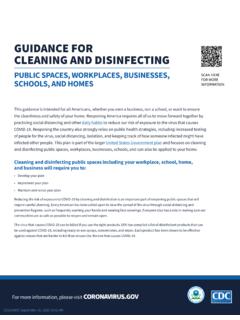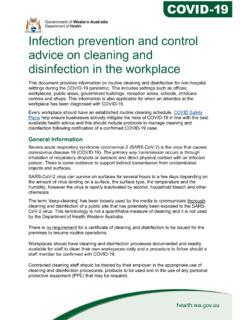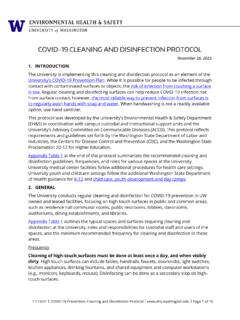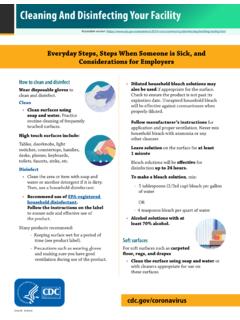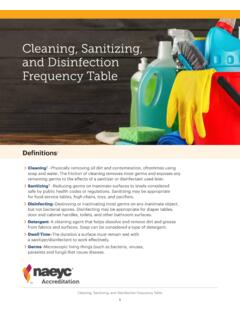Transcription of “CDC’s Cleaning and Disinfecting Guidance” (2021), …
1 CDC's Cleaning and Disinfecting guidance (2021), downloaded from on April 27, 2021. 4/27/2021 Cleaning and Disinfecting Your Facility | CDC. COVID-19. Cleaning and Disinfecting Your Facility Every Day and When Someone is Sick Updated Apr. 5, 2021 Print The virus that causes COVID-19 can land on surfaces. It's possible for people to become infected if they touch those surfaces and then touch their nose, mouth, or eyes. In most situations, the risk of infection from touching a surface is low. The most reliable way to prevent infection from surfaces is to regularly wash hands or use hand sanitizer.
2 Cleaning and Disinfecting surfaces can also reduce the risk of infection. Always follow standard practices and appropriate regulations speci c to your type of facility for minimum standards for Cleaning and disinfection. This guidance is indicated for buildings in community settings and is not intended for healthcare settings or for other facilities where speci c regulations or practices for Cleaning and disinfection may apply. When to Clean and When to Disinfect Cleaning with products containing soap or detergent reduces germs on surfaces by removing contaminants and may also weaken or damage some of the virus particles, which decreases risk of infection from surfaces.
3 When no people with con rmed or suspected COVID-19 are known to have been in a space, Cleaning once a day is usually enough to su ciently remove virus that may be on surfaces and help maintain a healthy facility. Disinfecting (using Environmental Protection Agency (EPA)'s List N ) kills any remaining germs on surfaces, which further reduces any risk of spreading infection. You may want to either clean more frequently or choose to disinfect (in addition to Cleaning ) in shared spaces if certain conditions apply that can increase the risk of infection from touching surfaces: High transmission of COVID-19 in your community, Low number of people wearing masks, Infrequent hand hygiene, or The space is occupied by certain populations, such as people at increased risk for severe illness from COVID-19.
4 If there has been a sick person or someone who tested positive for COVID-19 in your facility within the last 24 hours, you should clean AND disinfect the space. Routine Cleaning Develop Your Plan Determine What Needs to Be Cleaned Consider the type of surface and how often the surface is touched. Generally, the more people who touch a surface, the higher the risk. Prioritize Cleaning high-touch surfaces. Determine How Often To Clean 1/5. 4/27/2021 Cleaning and Disinfecting Your Facility | CDC. ete e o O te o C ea High-touch surfaces should be cleaned at least once a day. More frequent Cleaning might be needed when the space is occupied by young children and others who may not consistently wear masks, wash hands, or cover coughs and sneezes.
5 If the space is a high tra c area, or if certain conditions apply, you may choose to clean more frequently. Determine If Regular Disinfection Is Needed In most situations, regular Cleaning (at least once a day) is enough to su ciently remove virus that may be on surfaces. However, if certain conditions apply, you may choose to disinfect after Cleaning . Consider the Resources and Equipment Needed Keep in mind the availability of Cleaning products and the personal protective equipment (PPE) appropriate for cleaners and disinfectants (if needed). Implement Clean High-Touch Surfaces Clean high-touch surfaces at least once a day or as often as determined is necessary.
6 Examples of high-touch surfaces include: pens, counters, shopping carts, tables, doorknobs, light switches, handles, stair rails, elevator buttons, desks, keyboards, phones, toilets, faucets, and sinks. Protect Yourself and Other Cleaning Sta Ensure Cleaning sta are trained on proper use of Cleaning (and Disinfecting , if applicable) products. Wear gloves for all tasks in the Cleaning process. Wash your hands with soap and water for 20 seconds after Cleaning . Be sure to wash your hands immediately after removing gloves. - If hands are visibly dirty, always wash hands with soap and water. - If soap and water are not available and hands are not visibly dirty, use an alcohol-based hand sanitizer that contains at least 60% alcohol, and wash with soap and water as soon as you can.
7 Special considerations should be made for people with asthma. Some Cleaning and disinfection products can trigger asthma. Learn more about reducing your chance of an asthma attack while Disinfecting to prevent COVID-19. Disinfect Safely When Needed If you determine that regular disinfection may be needed If your disinfectant product label does not specify that it can be used for both Cleaning and disinfection, clean visibly dirty surfaces with soap or detergent before disinfection. Use a disinfectant product from the EPA List N that is e ective against COVID-19. Check that the EPA. Registration number on the product matches the registration number in the List N search tool.
8 See Tips on using the List N Tool . - If products on EPA List N : Disinfectants for Coronavirus (COVID-19) are not available, bleach solutions can be used if appropriate for the surface. Always follow the directions on the label to ensure safe and e ective use of the product. The label will include safety information and application instructions. Keep disinfectants out of the reach of children. Many products recommend keeping the surface wet with a disinfectant for a certain period (see product label). Always take necessary safety precautions. - Ensure adequate ventilation while using the product.
9 - Wear gloves. Gloves should be removed carefully to avoid contamination of the wearer and the surrounding area. Additional PPE, such as glasses or goggles, might be required depending on the 2/5. 4/27/2021 Cleaning and Disinfecting Your Facility | CDC. Cleaning /disinfectant products being used and whether there is a risk of splash. Use chemical disinfectants safely! Always read and follow the directions on the label of Cleaning and disinfection products to ensure safe and e ective use. - Wear gloves and consider glasses or goggles for potential splash hazards to eyes. - Ensure adequate ventilation (for example, open windows).
10 - Use only the amount recommended on the label. - If diluting with water is indicated for use, use water at room temperature (unless stated otherwise on the label). - Label diluted Cleaning or disinfectant solutions. - Store and use chemicals out of the reach of children and pets. - Do not mix products or chemicals. - Do not eat, drink, breathe, or inject Cleaning and disinfection products into your body or apply directly to your skin. They can cause serious harm. - Do not wipe or bathe people or pets with any surface Cleaning and disinfection products. See EPA's Six Steps for Safe and E ective Disinfectant Use.










